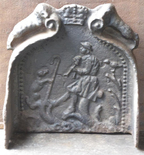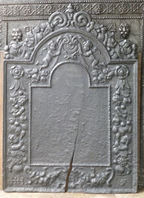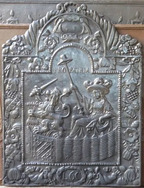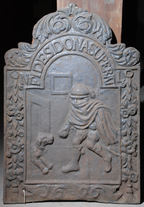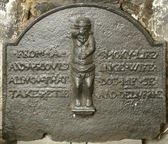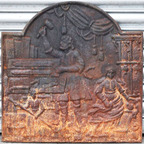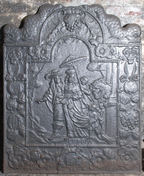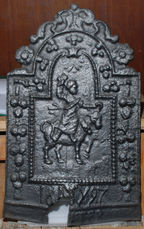-
1128
Description: Quasi-arched shape with forward-facing 'wings', which splay outwards towards the base; the 'wings' curve to follow the shape of the main panel but curl outwards at the top; central panel with pictorial image of, to the right, a shepherd holding a musical pipe, his right foot upon a log, upon which a dog, to the left, sits holding the shepherd's crook; top centre, a crown, on either side of which, on the curled upper parts of the 'wings', is an inward facing sheep.
Notes: Nothing is known about the sources of free-standing firebacks or what prompted their production. Their form is similar but the predominant use of horticultural or arboreal decorative themes, which suggests production within a limited time frame, has in this instance been replaced with a humorous scene. Only a very small number of such castings are known. Depth 210mm
- Decoration tags:
- free-standing (shape)
- none (edging)
- whole carved pattern
- heraldic
- pictorial
- animals
- humans
- plants
- objects
Manufactured: in the late-17th to early-18th century in England.
Current location: not known.
- Attached to series:
- Free-standing firebacks
-
1004
Description: Arched rectangular shaped central panel with bead edging; arched rectangular border with bead edging; fructal and floral festoons suspended on ribbons with two putti at the top and two on each side; in the left and right bottom corners, the initials 'HH' and 'S' respectively; at the bottom, a central cartouche with date (indistinctly), between floral swags; on top, twin spirals between descending floral festoons.
Notes: A border panel, without the central pictorial panel.
Copies of this fireback are known.
Inscription: HH S
Manufactured: in 1665 in the Siegerland area of Germany.
Current location: not known.
- Attached to series:
- 'Dutch' HHS series
- Base boards
-
1212
Description: Arched rectangular central panel with bead edging; wickerwork Garden of Holland (Hollandse Tuin) within which is seated a berobed female figure holding a cap of freedom on the end of a long pole; before her is the crowned heraldic lion of the States General of the Netherlands, clutching a sheaf of arrows in its left front paw; above are the words, Pro Patria; arched rectangular border with fillet edging; central cartouche at top, with festoons of fruit, flowers and leaves suspended on each side from ribbons supported by rings; at the bottom, swirled ribbon around an oval compartment bearing the inscription 'L6C'; on top, a central cartouche from which descend a cornucopia on each side of the arch.
Notes: An overtly patriotic theme with symbols of Dutch nationhood; the inscription at the bottom indicates the style of border; other firebacks with the same inscription have the same border; similar inscriptions (e.g. L7C and L8G) indicate different borders.
Inscription: PRO PATRIA / L6C
- Decoration tags:
- 'Dutch' (shape)
- fillet (edging)
- whole carved pattern
- pictorial
- allegorical
- text
- animals
- humans
- plants
- objects
Manufactured: in the late-17th century in the Siegerland area of Germany.
Current location: not known.
- Attached to series:
- 'Dutch' LC/G series
- 'Dutch' Garden of Holland firebacks
-
844
Description: Arched rectangular central panel; fillet edging; pictorial scene of a cloaked figure, to the right, tempting a dog, to the left, with a tasty morsel; behind are the outlines of a door and window; arched rectangular border with fillet edging, the date along the bottom; down each side, a floral festoon; over the arch, the inscription, the initials split between each side of the main inscription; on top, floral scrolls.
Notes: The inscription translates as 'loyalty above gifts'; some castings omit the initials, NL, indicating that they were a subsequent addition. The illustration is derived from 'The thief and the dog', one of a series of engravings of Aesop's Fables by Wenceslaus Hollar.
Copies of this fireback are known.
Inscription: N / FIDES DONA SUPERAT / L // 1696
- Decoration tags:
- 'Dutch' (shape)
- fillet (edging)
- whole carved pattern
- individual letters
- planklines
- pictorial
- allegorical
- text
- animals
- humans
Manufactured: in 1696 possibly in the Siegerland area of Germany.
Current location: English Heritage Store, Atcham Business Park, Atcham, Shropshire, England.
Museum number: EH ASC 4491 (part of the English Heritage museum group)
- Attached to series:
- 'Dutch' 1696 NL series
-
1209
Description: Individually designed quasi-arched rectangular shape; astragal edging; central portico with framed doorway and sloping roof, in which stands a male figure dressed in contemporary style; above the roof, the date, and above that, the initials R R separated by a flower head, this inscription enclosed within a five-sided ribbon compartment held at the top corners by a pair of mirrored dancing cherubs each of which holds in their outer hand a wand surmounted by a fleur-de-lys; below them are mirrored vine designs terminating in a grape bunch, and below each of them a mirrored swirled snake, its head reversed; towards the outer side of these snakes are a pair of mirrored birds within a curved cartouche of slightly raised relief that is associated with a swirl on each side of the fireback that terminates the astragal edging on each side and which ascends via a step surmounted by a miniature urn on each shoulder of the back to the top which is surmounted by an acorn shape; above the ribbons held by the cherubs, is a stylised crown between the initials GR; the above features are limited by a horizontal astragal, though the portico descends below it, and which is supported at each end by a simple Doric column enclosing the bottom panel which is otherwise plain.
Notes: The initials GR are of Georgius Rex - King George I. Finely cast but of naïve design, another fireback of the same design but with different inscriptions and dated 1714 is at Low Graythwaite in Hawkshead parish, which was home to the Rawlinson family who, in 1711, built the first blast furnace in what was then the northern part of Lancashire.
Inscription: G R / R R / 1723
- Decoration tags:
- rectangular with round arch (shape)
- astragal (edging)
- whole carved pattern
- individual letters
- individual numbers
- heraldic
- mythological
- text
- humans
- plants
Manufactured: in 1723 possibly at Backbarrow Furnace in the Furness area of England.
Current location: Blackwell House, Bowness-on-Windermere, Cumbria, England.
- Attached to series:
- Rawlinson series
-
993
Description: Arched rectangular shaped; ovolo-moulded edging (top and sides); central stamp of a carved bracket figure of a bearded man in a loincloth and cap; rhyme in capitals across rectangular plate, letters carved on strips, split by figure.
Notes: The twin miseries of a smoky house and a scolding wife are mentioned several times in literature. The dress of the figure suggests work as a miner, possibly linking this back with the Forest of Dean. Variants with initials and dates are also known.
Inscription: FROM ·A·-·SMOKY ·LIFE·/ AND·A SCOVL DING·WIFE·/ALL MEN THAT-DOE·ME·SE/ TAKE·PETIE- AND·DELIVER ME
- Decoration tags:
- rectangular with round arch (shape)
- ovolo (edging)
- carved stamps
- text
- humans
Manufactured: in the mid-17th century possibly at Tintern Furnace in the Forest of Dean area of Wales.
Current location: Westwood Manor, Bradford-on-Avon, Wiltshire, England.
Museum number: 222507 (part of the National Trust museum group)
Citation: Chambers, L. H., 26 Sep 1912, 'Fireback: Relic of 1660', Notes and Queries, 11th series, 6, p. 230.
- Attached to series:
- Twin miseries series
- Figurine firebacks
-
1269
Description: Arched rectangular shape; fillet edging; central male figure clothed in 17th century style, facing to the left, holding a mallet in his raised right hand and holding a board with rectangular detailing in relief in his left hand; vertical boards in relief behind; below to the left, a smaller figure holding a long pole diagonally with other detailing in relief behind; to the lower right, a female figure, contemporaneously clothed, a scroll feature to her right; behind, an archtectural grille with scrolled detailing; above, swagged drapery with three descending tasselled ropes.
Notes: A pastiche of a 17th century fireback. The scene appears to be of a carpenter's workshop but some of the detail in the lower parts of the fireback is indistinct owing to corrosion. The drapery was probably inspired by a similar feature on several late-17th or early-18th century 'Dutch'-style fireback designs. The reverse (upcast) side of the fireback is very smooth indicating a modern date for the casting.
- Decoration tags:
- rectangular with round arch (shape)
- fillet (edging)
- whole carved pattern
- pictorial
- humans
- objects
Manufactured: in the 20th century in France.
Current location: Raflees Reclamation Ltd, Trefusis Lodge, Tone Green, Bradford-on-Tone, Somerset, England.
- Attached to series:
- Miscellaneous pattern firebacks
-
219
Description: Arched rectangular central panel with bead on fillet edging, pictorial representation of a man and woman walking, behind the woman a child holds her train and a young person carries a parasol; from behind a column on the right, a horse's head is visible, a tree stands to the left, at the foot of the scene is the word 'EUROPA'; arched rectangular border with fillet edging, from a central bunch of grapes at the top of the arch, a ribbon on each side suspends bunches of fruit and flowers; at the bottom a central cartouche containing the inscription 'L7G', with flowers on each side;; on top are two mirrored dolphins.
Notes: The pictorial scene is based on an engraving c.1642 of Friedrich Wilhelm, Elector of Brandenburg, and his wife, Luise Henriette of Oranje-Nassau, by Mathias Czwiczek; one of series of firebacks depicting allegories of the four continents; the initials, L7C, denote the style of border - other firebacks having the same inscription have the same border - and other borders are denoted by similar inscriptions (e.g. L6C and L8G).
Copies of this fireback are known.
Inscription: EVROPA / L7C
Manufactured: in the mid- to late-17th century in the Siegerland area of Germany.
Current location: Preston Manor, Brighton, East Sussex, England.
Museum number: HA105000 (part of the Brighton Museum museum group)
- Attached to series:
- 'Dutch' LC/G series
- 'Dutch' Continents firebacks
-
212
Description: Arched rectangular central panel, bead edging, female figure, her right arm raised, sitting on a bull; arched rectangular border, fillet edging, swags of fruit bunches suspended from ribbon, inscription below central panel; on top, symmetrical floral swirls and flowers; plain panel at bottom.
Notes: The image is of Europa being carried away to Crete by Zeus disguised as a bull.
Copies of this fireback are known.
Inscription: 16 NDW 97
- Decoration tags:
- 'Dutch' (shape)
- fillet (edging)
- whole carved pattern
- pictorial
- mythological
- monogram
- text
- animals
- humans
Manufactured: in 1697 in the Siegerland area of Germany.
Current location: Brighton Museum and Art Gallery, Brighton, East Sussex, England.
Museum number: HA105015 (part of the Brighton Museum museum group)
- Attached to series:
- 'Dutch' NDW series
-
214
Description: Rectangular with arched, mirrored scrolls on top and central scallop shell; fillet edging; in a grove with two putti above, blowing trumpets, to the left, a naked female figure seated against a table, pointing at three children to the right, on a rock; at the bottom, narrow panel with indistinct decoration.
Notes: The scene is probably from classical mythology, but has not been identified.
Copies of this fireback are known.
- Decoration tags:
- rectangular with ornate arch (shape)
- fillet (edging)
- whole carved pattern
- pictorial
- mythological
- humans
- plants
Manufactured: in the early-18th century in England.
Current location: Brighton Museum and Art Gallery, Brighton, East Sussex, England.
Museum number: HATMP002269 (part of the Brighton Museum museum group)
- Attached to series:
- Late pictorial series (all)
- Late pictorial series 2
